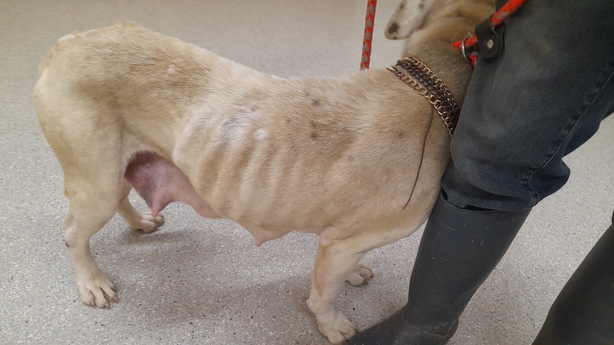A dog attack on Thursday has left a woman (50s) in south Dublin hospitalised with serious injuries. It's the latest in a string of serious dog attacks in recent months. Despite these attacks, some animal welfare groups are not convinced that banning certain dog breeds will address the issue.
Gardaí have begun an investigation into a dog attack at a residential property in Dun Laoghaire which has left a woman (50s) hospitalised.
The dogs involved in the attack are understood to be bulldogs, however, it is not clear if the animals are on the list of restricted breeds.
The incident is the latest in a string of serious dog attacks, often involving restricted breeds.
Earlier this year, Raul Mizsan attended Wexford Circuit Court as the owner of the XL Bully that attacked his brother was sent to prison.
In November 2022, nine-year-old Alejandro Mizsan was playing with three friends in Enniscorthy, Co Wexford, when he was attacked by an XL Bully.
Alejandro spent seven weeks in Crumlin Children’s Hospital being treated for facial injuries and will require ongoing surgeries in the coming years.
Gardaí later established the same XL Bully had attacked another young boy four days beforehand, but his padded coat took the brunt of the dog bite, and he wasn’t badly injured.
The owner of the XL Bully who attacked Alejandro was jailed for two years for offences including endangerment. The dog had not been registered or microchipped.
Speaking to Prime Time, Raul said he was grateful to see justice for his brother.

The attack on Alejandro was one of a number of high-profile incidents involving XL Bullies in recent years, that ultimately led to the introduction of a ban that will come into effect on 1 October.
Last month, a 12-month-old baby girl was hospitalised after being seriously attacked by an XL Bully in the village of Lixnaw, Co Kerry.
In June, Nicole Morey from Limerick was killed by her pet XL Bully dog after she returned home from celebrating her 23rd birthday.
Ms Morey's case spurred on Minister for Rural and Community Development Heather Humphreys to introduce the ban on XLs.
The ban will mean that the importation, breeding, sale, and rehoming of XL bullies will be restricted.
However, some animal welfare groups are not convinced a ban is the right way to address the issue.
Chief Executive of the Irish Society for Prevention of Cruelty to Animals (ISPCA) Cyril Sullivan told Prime Time "from an animal welfare point of view – bans don’t work. It’s not the breed, it’s the deed."
"What you are going to find is that individuals who are good solid responsible owners will come forward for their certificate of exemption, they’ll have their dog, and they’ll be able to live with their dog, and it’ll be a friendly dog, that’s the way those dogs are."
"Those who are less scrupulous, who will take the dog, not for a pet, but maybe for other reasons, will just ignore this [ban] and just continue on, and if anything, it will just drive this underground."
For some XL bullies, the future is uncertain. At an ISPCA shelter in Co Longford, an XL Bully and her emaciated pups have been recovering from mistreatment since November 2023.

When they arrived at the shelter, all the puppies had umbilical infections, some had mange, and the mother had a bad skin infection.
The ISPCA told Prime Time the dogs have been nursed back to health, and even socialised with walks, play and exercise.
Up until 1 October, these XL Bullies can be rehomed but finding homes is difficult, given the number of recent attacks.
At the four ISPCA centres across the country, which cater for rescued animals, there are 182 dogs. 71 in the Longford centre; 55 in Wicklow; 27 in Mallow; and 29 in Donegal.
Twenty-three of that total figure of 182 are XL Bully dogs, including 10 in Longford.
The ban in the Republic of Ireland will see the adoption of the same definition as in the UK of what an XL Bully is.
The dog is largely a cross-breed of the American Bully and the Staffordshire Bull Terrier. Many breeders have bred this dog to get greater definition and muscularity – so that it has a large blocky head, its jaws are stronger, its ears more defined, its chest broader and limbs stronger than other restricted breeds.
The Irish State will define a male XL Bully as having a height of not less than 51cm at the highest part of its back – known as the 'withers'. An adult female XL Bully will be defined as having a height not less than 48cm at the withers.
The intention is that the XL Bully breed will be neutered and then allowed die out naturally over the course of the next number of years.
Owners who get their XL Bully micro-chipped, spayed and who have a dog licence, will be allowed apply for a Certificate of Exemption by 1 February 2025. If successful, they can keep their dog for the rest of the dog’s natural life.
Enforcement
Dog control statistics for 2023 – compiled by every local authority – are yet to be published by the Government.
But the figures for 2022 show there were 791 incidents of aggressive dog behaviour with 308 people physically injured.
The figures also show there were 52 full-time and 22 part-time dog wardens working throughout the country that year. Stark figures when you consider over 205,000 dog licenses were issued that year.
Minister Humphreys recently announced fresh funding of €2m between the various local authorities which is expected to see up to 40 more dog wardens employed in the coming months.
A need for greater enforcement of current laws is a big issue. Almost 1,700 fixed charge notices – for offences like not having a restricted dog on a lead – were issued in 2022, and only about half were paid.
Meanwhile, Alejandro, now 11, is back at school in Co Wexford and has another surgery scheduled for later this year.
Raul says the doctors say he is healing well but that the operations are expensive.
"There is a long road ahead of him. Please God everything will be ok with him."
Reporter Barry Cummins and producer Brídóg Ní Bhuachalla’s report about dangerous dogs will be broadcast on Prime Time on 5 September 2024.








